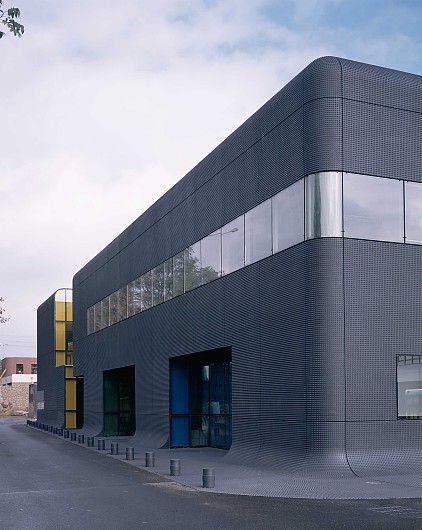
Thiais RATP Bus Center: Creation of the new administrative building
Emmanuel Combarel and Dominique Marrec, architectes. Paris
Texte Paul Ardenne

«As one of the world's largest urban transport companies and technology pioneer, it is only natural that RATP's buildings should reflect the company's image », states Rémi Feredj, Real Estate Manager for RATP. « The Thiais building certainly meets this requirement. It helps to improve the site's urban landscape. It is the pride of the hundreds of people who will be working there and represents a sign of belonging and a symbol of what we are all about ».
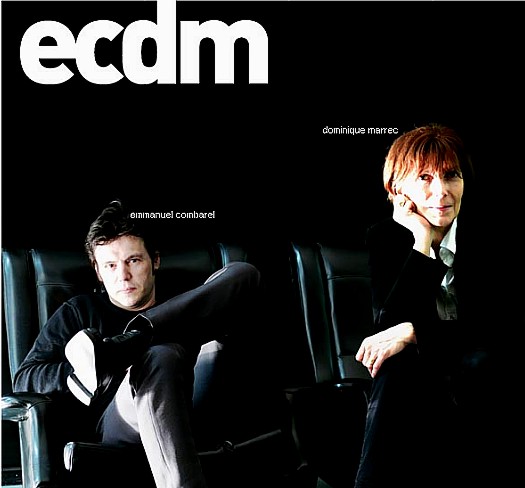
Based near Orly airport and Rungis wholesale food market, this administrative complex comprises various services on the site. As well as a secure control center which manages three hundred buses, the new bus center building also houses a rest area with facilities, open round the clock, for use by the managers, service personnel and bus drivers. The building was designed by architects Emmanuel Combarel and Dominique Marrec from the Paris-based firm ECDM. RATP appointe dits real estate subsidiary, SEDP, as project manager.
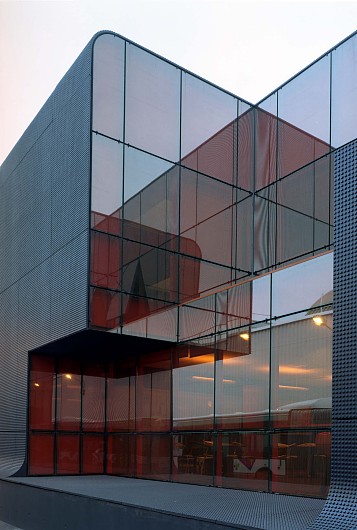
The area surrounding the new periurban-styl building is cluttered with major
brand warehouses and industrial buildings, wide streets and junctions. ECDM's
challenge was to reconcile functionality with integration, and design a
relay-type building which blends into the scenery while, at yhe same time,
forming a modern and attractive focal point. The architects plumped for spatial
continuity. Shaped like an elevated plateau, the building looks as though it is
rising out of the road or growing out of, and fusing With, a landscape of
unbroken minerality.
This effect is achieved by covering the entire building and a large tarmac strip
surrounding it in Ductal, Which has a strong mineral homogeneity. This elegant
concrete « skin » runs along the edge of the building before rising up so that
the building ( roof included ) and road merge into a sigle coherent structure -
bestowing the new Thiais Bus Center building with its unique identity.
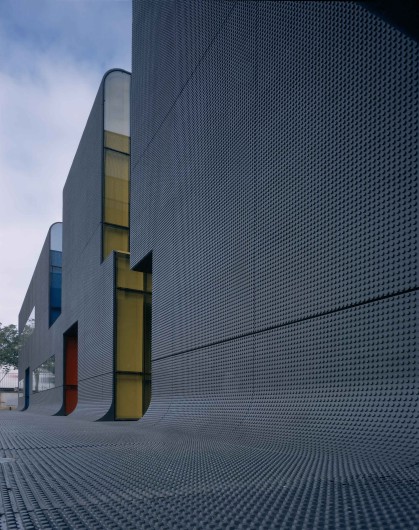
ECDM (Paris)
The designers of the new Thiais RATP bus Center building are Emmanuel
Combarel and Dominique Marrec, foundres of ECDM ( Paris), set up in 1993. Both
are ardent supporters of contextual architecture, taking structure,
restrictions linked to function and the socio-cultural concerns of the
surroundings into account. ECDM ‘s style combines light, cohesion and esthetics
and effective simplicity is also a priority. « One dominant characteristic can
be found in the firm's work, as expressed by Marrec and Combarel themselves. It
is the desire to offer simple architecture with rigorous logic and without
preconceptions, nostalgia or stylistic concerns ».
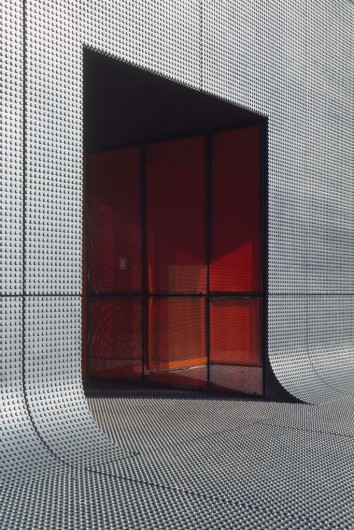
ECDM is behind many constructions, such as the Espacil Habitat student
residence in Argenteuil, awarded the « Equerre d'Argent » in 2003, and La
Tourelle school sports complex in Sarcelles (2005), where an elegant shelter
now runs the full lenght of the sports field. This building provides an
outstanding example of ambient lighting technology. Other projects include the
HQE (French environmental quality standard) residence in Rue Louis Blanc (2006)
for the Paris housing authority RIVP, built over a ground-floor landscaped car
park and characterized by its roadside backlit façade.
Designing the Thiais Bus Center provided ECDM with the perfect opportunity to
express its practical and reflective approach to architecture. The challenge
was two-fold. On the one hand, it was required to meet strict specifications
which included housing monitoring, management, reception, meeting and
relaxation facilities on the same site. And on the other hand, it was required
to experiment with new physical and sensitive relationships to materials,
including the ultrahigh performance concrete Ductal. In the case of the Thiais
project, Ductal is the architect's trump card, used as cladding to cover the
building as a physical, esthetic element to merge the ground, walls and
underside of the building into one.
Balance and unity
When workingin the actual context, Emmanuel Combarel and Dominique Marrec
never have a preconceived idea of what the finished building will actually look
like. After a lengthy observation and survey phase which generally involves
consulting future users, the architects designed an administrative unit which
is both ambivalent and suggestive, organically emphasizing continuum rather
than rupture.
« Our aim was to focus on the site's mineral nature and design a building that
merged with and grew out of the road », said Dominique Marrec. Built next to
the old Bus Center and coach depot - both typical examples of industrial
architecture - the new building supplements, and yet forms part of, the
existing site, its cube-like form rising up in relation to the surroundings.
The new Bus Center is characterized by the vast extent of concrete surrounding
the administrative area and covering the adjacent road wnich welcomes the
constant fleet of buses. The architects wanted to extend the road into the
building to give the impression that it had suddenly emerged from the ground
like a beautifully risen cake. The idea of designing a « skin »-type covering
for the surrounding area and the building emerged quite naturally. This skin «
creates the impression that the flow of traffic and the building are blurred
together, endowing the site with a powerful visual density ».
This skin looks like the world-famous pattern on a piece of Lego, except that
it is enlarged and reproduced ad infinitum. It is consistently gray in color
and covers the ground around the building together with its walls and roof.
Made from tinted Ductal, it is attached as cladding to the building itself and
laid flat around the base. In addition, this pattern of regularly repeated
studs meets the specifications requirements for an anti-slip surface. It is a
perfect blend of effect and function. The ease with which Ductal can be molded
further enhances the esthetic effect. The top edges of the building are
beautifully rounded without the slightest hint of aggression. There is no
facadism and no front or back ti this building whose entire structure
exemplifies unity, from its design through to its style.
A distinctive building
The new Thiais Bus Center is characterized by its rare physical, conceptual
and æsthetic uniformity. Clad in its Ductal apparel, the building resembles a
model in a skin-tight dress.
The openings in this monolithic-type block look like they were cut out of the
building after it was built with a giant Stanley knife. But this apparent
radical quality is only skin deep. In fact, grace and elegance is evident
throughout this building which invites you to enter and wander along its light
and airy passageways, leading directly through the building and out again to
the other side.
The different color schemes used to distinguish the various indoor areas
together with the spacious offices, generous lighting and attractive indoor
patio area, bathed in a pool of light, all bear witness to this elegance which
makes the building pleasing to the eye and a comfortable place to work in.
Even the reflective structural glazing conveys a sense of elegance, with its
tinted or partially frosted glass creating multiple reflections and morror-like
effects.
Independently of its administrative functions, the new Thiais Bus Center is
intended to represent a miniature version of the surrounding environment. The
openings are decorated, on the outside, in four different colors (blue, green,
yellow and orange), contrasting sharply with the gray concrete. This is no
decorative fancy but rather a deliberate decision to use minimalist polychrome
which has a strong impact and again stems from the desire for symbolic
symbiosis. These colors have been carefully chosen and are a physical
reproduction of the equally loud colors displayed on the shop signs and
billboard in the nearby shopping district : « We have reused the primary,
rather basic colors found in the surrounding area », said the architects. This
remarkable building is sure to elicit two responses. Firstly, it catches the
eyes, its high architectural quality and bombastic appearance naturally
arousing curiosity. And secondly, it generates discussion. Yet, this new
building is far from an example of radical autonomy and is no UFO either,
despite its unusual characteristics.
This building is neither provocative nor out of touch with reality. But nor
does it bow down to « poor quality » urbanity- a common characteristic of the
neighboring buildings. ECDM's building is both divergent and convergent. It
forms part of the local area while, at the same time, adding something to it.
More than just adding soul
Despite the fact that Thiais' unusual new Bus Center building is set in an
environment filled with ultra-funcional, low-cost buildings with very little architectural
symbolism, it is not provocative or defiant. Its cube-like form calls to mind
the warehouse-type outlets in the nearby shopping district. Its low height (
R+1) is similar to the horizontal buildings in the surrounding area. On the top
of the building, the Ductal façade rises skyward, ensuring visual continuity
between the surronding area and the buiding itself, enchancing, rather than
diminishing, this extremely graphic attempt at insertion. The building is set
firmly in context and gives priority to functionality of use.
Above all else, Emmanuel Combarel and Dominique Marrec have designed the
building specifically for purpose as the well thought-out interior design
testifies. The Thiais RATP Bus Center is, nonetheless, a quite definite
architectural desture or signature. Everything about this building is
distinctive. It cannot be compared to any other building or considerd an
imitation fo any existing structure.
« It's a question of refusing absolute architecture », say Marrec and Combarel,
« and focusing on adapting the building to its surroundings ». The architects'
intelligence is reflected in their work which is devoid of all prejudice and
refuses to conform to any rules.
For example, contrary to expectations, their aim in using Ductal as a layer of
skin is not to flaunt the concrete's exceptional physical qualities, but
rather, in accordance with an original decorative perspective, to highlight its
power to seduce, its visual potential and the unusual elegance of its mineral
quality. This propensity to humanize a supposedly « hard » material brings to
mind the work of architect Marcel Breuer, at odds with elementary
functionalism. When designing buildings, this great master of concrete
architecture liked to think of them as «sculptures with a function»
In recent decades, architecture's «sculptural evolution» has places its faith
in sizeable proportions. The familiar, often disappointing result of this
approach is that free from takes precedence over function and its specific
layout requirements. In its own lively but non-aggressive way, the new Thiais
Bus Center building provides the occasion for revival. Its incomparably
handsome appearance is combined with its precisely calibrated funcionality.
Here, poetry merges with purpose in keeping with a complexe way of thinking
which combines the architect's quest for pure creation with the essencial
requirement for architectural efficiency. So, more than just adding soul, it's
all about designing a building which is just right.